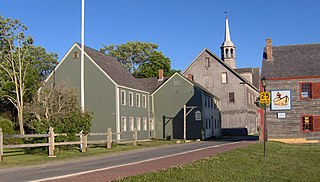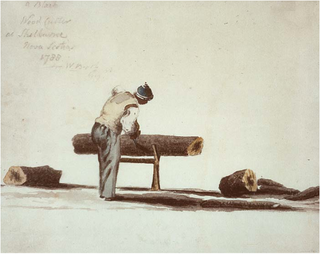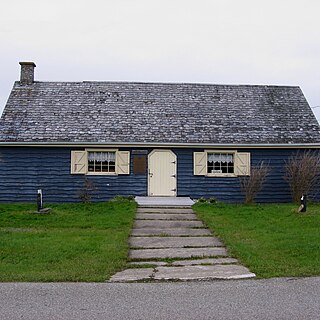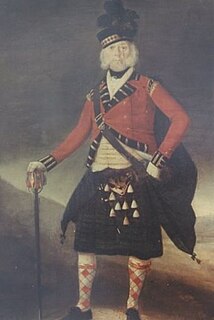Related Research Articles

Windsor is a community located in Hants County, Nova Scotia, Canada. It is a service centre for the western part of the county and is situated on Highway 101.

Eastern Passage is an unincorporated suburban community in Halifax Regional Municipality Nova Scotia, Canada.

River John is an unincorporated community in Pictou County, Nova Scotia, Canada.

Shelburne is a town located in southwestern Nova Scotia, Canada. It is home to the Bowers Meadows Wilderness Area.
The Canadian Association of Elizabeth Fry Societies (CAEFS) is an association of groups operating under the Elizabeth Fry Society banner, similar in many respects to the John Howard Society. The Elizabeth Fry Society groups work on issues affecting women, girls and gender diverse people in the justice system. The societies take their name from prison reformer Elizabeth Fry.

Port Williams is a Canadian village in Kings County, Nova Scotia. It is located on the north bank of the Cornwallis River, named after Edward Cornwallis, first governor of Nova Scotia. As of 2016, the population was 1,120.

Scouting in Nova Scotia has a long history, from the 1900s to the present day, serving thousands of youth in programs that suit the environment in which they live.

Citadel High School is a high school in Halifax, Nova Scotia, Canada.

Black Nova Scotians or African Nova Scotians are Black Canadians whose ancestors primarily date back to the Colonial United States as enslaved people or freemen, and later arrived in Nova Scotia, Canada during the 18th and early 19th centuries. As of the 2016 Census of Canada, 21,915 Black people live in Nova Scotia, most in Halifax. Since the 1950s, numerous Black Nova Scotians have migrated to Toronto for its larger range of opportunities. Before the immigration reforms of the 1960s, Black Nova Scotians formed 37% of the total Black Canadian population.

Nicolas Denys was a French-born merchant, governor, author, and settler in New France. He founded settlements at St. Pierre, Ste. Anne and Nepisiquit.

Grandique Ferry is a former community in Richmond County, Nova Scotia.
John Alexander Barry was born in Shelburne County, Nova Scotia and was the son of Robert Barry, a loyalist who came to Shelburne in 1773. His first wife was the daughter of the Reverend William Black, a Methodist minister.

Birchtown is a community and National Historic Site in the Canadian province of Nova Scotia, located near Shelburne in the Municipal District of Shelburne County. Founded in 1783, the village was the largest settlement of Black Loyalists and indeed, the largest free settlement of ethnic Africans in North America in the eighteenth century. The two other significant Black Loyalist communities established in Nova Scotia were Brindley town and Tracadie. Birchtown was named after British Brigadier General Samuel Birch, an official who helped lead the evacuation of Black Loyalists from New York.

Boisdale is a community in the Canadian province of Nova Scotia, located in the Cape Breton Regional Municipality on Cape Breton Island. It was named for Lochboisdale, the main village of the island of South Uist in the Outer Hebrides of Scotland. Neil Campbell was granted land in the area in 1836. In 1821, Thomas Lockman, an Irishman who came to Cape Breton in 1799 and lived at Lloyds Cove, petitioned for land, and got a grant next to Neil Campbell's lot in 1842. Angus McIntyre got a grant in 1846, and in 1869, land at what was then called Boisdale was granted to Dugald O'Henley. Farming and lumbering were the basic industries. In 1840, a small log church was constructed by Father John Grant on where the present-day church resides. It was replaced by a new building in 1862, which burned down in September 1928. In 1846, Boisdale Parish was officially erected. A post office was established at Boisdale Chapel in 1854. On October 1, 1873 a new post office was established with Michael McIntyre as office keeper. In 1874, the total population of Boisdale, was that of 500. During this time, the area had 1 store, 3 sawmills, 1 grist mill, and a post office, of which mail was delivered bi-weekly. By 1908, it contained 1 hotel, 2 general stores, 1 saw mill, and 2 gristmills. The population at that time, was 300. In 1915, a newer 40,000 gallon open-wood tank was built replacing an older 40,000 gallon wood tank, for the water services within the area. Father Alexander F. MacGillivray, whom was the fifth pastor of Boisdale, had installed the bell within St. Andrew's Church in Boisdale, in 1882, and had built the Glebe house there in 1890. A new and larger bell, cast by the Meneely Bell Company of New York, was installed in St. Andrew's Church, by Father MacGillivray, on Nov. 14, 1897. In 1921, Father Gillis built St. Andrew's Parish Hall, James Johnston of Red Islands, Nova Scotia was the contractor. The formal opening of the hall was held on September 13, 1921. The original St. Andrew's Parish Church was destroyed by fire on Sunday, September 11, 1927. Construction of a new stone church commenced in June 1929, with help from workers from Quebec. The design style of the church was inspired by the Norman architecture as well as the St Mary the Virgin, Iffley church in England. Link, Weber, and Bowers, architects hailing from Pittsburgh, Pennsylvania, designed the architecture of the church. The approximate cost of the church was $55,000, but the exterior walls had to be repointed during the summer of 1930, which added an extra $7,500 to the total cost. The new church was blessed on Sunday, August 31, 1930, by Bishop James Morrison, assisted by the late Bishop Alexander MacDonald. In 1931, the total population of Boisdale was 449. There was also a train station located on Station Road, in Boisdale during this time. The former Glebe House for St. Andrew's Church was burnt down in 2011, due to a fire. Dugald Smith was the teacher in 1839, and a school-house had been constructed by that time. A new school-house was completed in 1917. Education within the area dates back to the early 1800s, with the Boisdale Consolidated School closing in 2003. The enrolment for the school, in the 1957–1958 academic year, were 82 students, and 3 teachers. By the 1987 Academic year, there were only 21 students, all within grades primary-second, and fourth. In 1943, within what is now known as Ironville, then known as Boisdale Barrachois until 1907, a youth summer camp was built. The two-week summer camp operated from 1943, until its closure in the 1980s. Efforts were made in 1997 to re-open the camp in the spring of 1998. The camp officially closed in 2010, due to the deterioration of some of the buildings. The property in which the youth camp was on, was sold in 2013. In August 1977, the community of Boisdale, as well as Father Webb, unveiled and held a ceremony for the opening of an indoor stone, ice-skating rink. Father Webb also built a Co-op store, in the 70s. A new hall above the store replaced the old Holyrood Hall, which burned down on December 18, 1975. By 1956, the population of Boisdale was 133. Over the years the population decreased, down to 138 by 1991, and estimated to be 105 by the 2001 Census.To the Hill of Boisdale,a book on the genealogical history of Boisdale was published in 1986, and later in a revised edition in 2001, by Father Allan MacMillan, then Priest of the Diocese of Antigonish. Highland Gold Maple, a family-owned and operated sugar maple producer, has been operating within the area for over fifteen years. In late April 2018, their operation burned to the ground due to a fire. By March 2019, Highland Gold Maple had rebuilt the Sugar Shack and are back in operation.

Windsor Forks is a community in the Canadian province of Nova Scotia, located in the Municipal District of West Hants.

St Mary's Bay Academy (SMBA) is a secondary school located in Weymouth, Nova Scotia. SMBA is part of the Tri-County Regional School Board and is the only English high school in the municipality of Clare. It was formerly known as Clare District High
James Harding may refer to:

Ranald MacKinnon was a soldier and a civil servant of the British Empire from 1758 until his death in 1805.
Amos Parker Pentz was a Canadian shipbuilder from Shelburne, Nova Scotia. He was noted for his fast and innovative designs of fishing schooners and trawlers.
The Royal Nova Scotia Historical Society is a historical society in Halifax, Nova Scotia that was founded in 1878 and is the second oldest in Canada The Society is a voluntary organization that operates without an office or paid staff. The Society first published the Nova Scotia Historical Quarterly and then the Nova Scotia Historical Review. Eventually the publication was named the Collections of the Royal Nova Scotia Historical Society and now it is known as the Journal of the Royal Nova Scotia Historical Society.
References
- ↑ Jackson,Lewis. "Citing Website" James Harding: Master Shipbuilder. 31 March 2002. Shelburne County Genealogical Society Accessed February 11, 2013,http://nsgna.ednet.ns.ca/shelburne/virtual/Jackson_en.html
- ↑ "Citing Website" James Harding Virtual Exhibit: Family Tree. Shelburne County Genealogical Society Accessed February 11, 2013, http://nsgna.ednet.ns.ca/shelburne/Tree_en.html
- ↑ Jackson,Lewis. "Citing Website" James Harding: Master Shipbuilder. 31 March 2002. Shelburne County Genealogical Society Accessed February 11, 2013,http://nsgna.ednet.ns.ca/shelburne/virtual/Jackson_en.html
- ↑ Jackson,Lewis. "Citing Website" James Harding: Master Shipbuilder. 31 March 2002. Shelburne County Genealogical Society Accessed February 11, 2013,http://nsgna.ednet.ns.ca/shelburne/virtual/Jackson_en.html
- ↑ Jackson,Lewis. "Citing Website" James Harding: Master Shipbuilder. 31 March 2002. Shelburne County Genealogical Society Accessed February 11, 2013,http://nsgna.ednet.ns.ca/shelburne/virtual/Jackson_en.html
- ↑ Jackson,Lewis. "Citing Website" James Harding: Master Shipbuilder. 31 March 2002. Shelburne County Genealogical Society Accessed February 11, 2013,http://nsgna.ednet.ns.ca/shelburne/virtual/Jackson_en.html
- ↑ Jackson,Lewis. "Citing Website" James Harding: Master Shipbuilder. 31 March 2002. Shelburne County Genealogical Society Accessed February 11, 2013,http://nsgna.ednet.ns.ca/shelburne/virtual/Jackson_en.html
- ↑ Jackson,Lewis. "Citing Website" James Harding: Master Shipbuilder. 31 March 2002. Shelburne County Genealogical Society Accessed February 11, 2013,http://nsgna.ednet.ns.ca/shelburne/virtual/Jackson_en.html
- ↑ Jackson,Lewis. "Citing Website" James Harding: Master Shipbuilder. 31 March 2002. Shelburne County Genealogical Society Accessed February 11, 2013,http://nsgna.ednet.ns.ca/shelburne/virtual/Jackson_en.html
- ↑ Jackson,Lewis. "Citing Website" James Harding: Master Shipbuilder. 31 March 2002. Shelburne County Genealogical Society Accessed February 11, 2013,http://nsgna.ednet.ns.ca/shelburne/virtual/Jackson_en.html
- ↑ Jackson,Lewis. "Citing Website" James Harding: Master Shipbuilder. 31 March 2002. Shelburne County Genealogical Society Accessed February 11, 2013,http://nsgna.ednet.ns.ca/shelburne/virtual/Jackson_en.html
- ↑ James H. HardingThe Chronicle HeraldJuly 11, 1978 p.22. Print